Porsche GmbH had manufactured about one hundred chassis for their unsuccessful proposal for the Tiger tank, the “Porsche Tiger”. Both the successful Henschel proposal and the Porsche design used the same Krupp-designed turret.
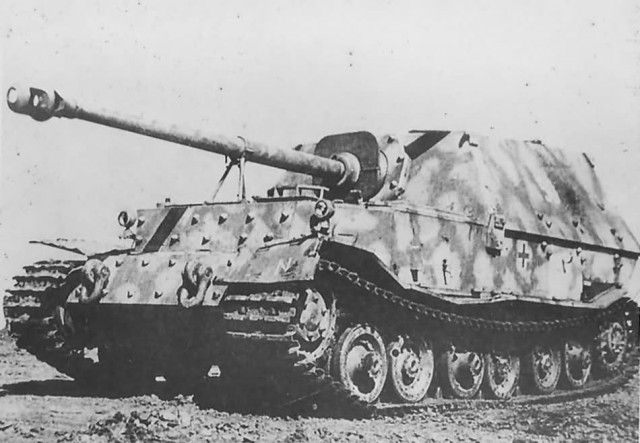 Ferdinand Panzerjager Tiger (P) number 501, Eastern Front Operation Citadel 1943
Ferdinand Panzerjager Tiger (P) number 501, Eastern Front Operation Citadel 1943Since the competing Henschel Tiger design was chosen for production, the Porsche chassis were no longer required for the Tiger tank project. It was therefore decided that the Porsche chassis were to be used as the basis of a new heavy tank destroyer, Ferdinand, mounting Krupp’s newly developed 88 mm Pak 43/2 anti-tank gun.
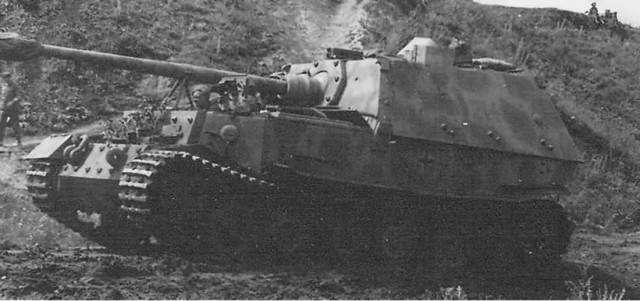 Ferdinand Panzerjager number 214 Sdkfz 184
Ferdinand Panzerjager number 214 Sdkfz 184The engines had already been placed in the middle of the hull to accommodate the Krupp-designed turret and that placement gave room on the Ferdinand for the anti-tank main gun armament at the rear. The gun was mounted in a simple casemate-style box structure, with slightly sloped sides, on top of this chassis.
The driver and radio operator were in a separate compartment at the front. As the engines were placed in the middle, the radio operator and the driver were separated from the rest of the crew and could be addressed only by intercom.
Add-on armor of 100 mm was bolted to the front plates, increasing the plate’s thickness to 200 mm and adding another 5 tons of weight.
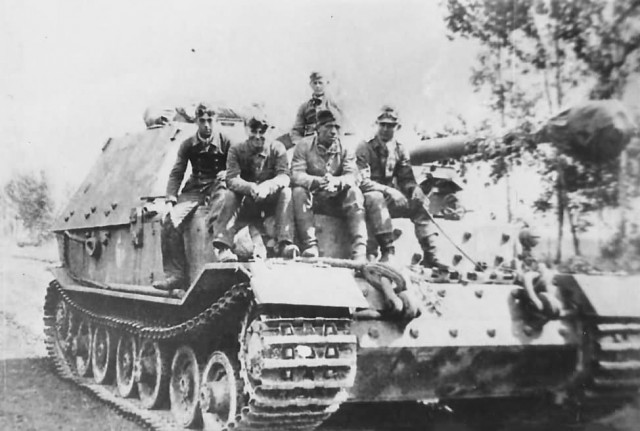 Ferdinand number 133 of the 1/653 Schwere Panzerjäger-Abteilung, August 1943 eastern front. Commander: Fw. Heinz Rempel.
Ferdinand number 133 of the 1/653 Schwere Panzerjäger-Abteilung, August 1943 eastern front. Commander: Fw. Heinz Rempel.The Maybach HL 120 TRM engines drove a single generato which powered two electric motors, one each connected to each of the rear sprockets. The electric motors also acted as the vehicle’s steering unit.
This “petrol-electrical” drive delivered 0.11 km/l off road and 0.15 km/l on road at a maximum speed of 10 km/h off road and 30 km/h on road.
In addition to this high fuel consumption and poor performance, the vehicle was also maintenance-intensive; the sprockets needed to be changed every 500 km.
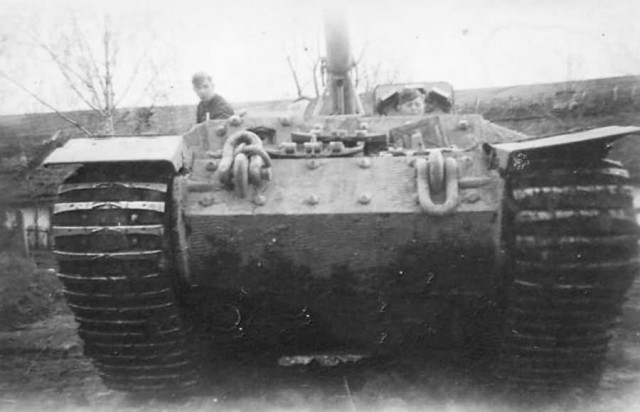 Panzerjager Tiger (P) Elefant of the Panzer Jg Abt. 653
Panzerjager Tiger (P) Elefant of the Panzer Jg Abt. 653The vehicle was fitted with an 88 mm Panzerabwehrkanone 43/2 gun. This 71 caliber-long gun had originally been developed as a replacement for the famous 88 mm anti-aircraft gun that had been used against Allied tanks in the Western Desert Campaign.
It had a much longer barrel than the L/56 guns, which gave it a higher muzzle velocity, and fired a different, longer cartridge. These improvements gave the 88 mm L/71 significantly improved armor penetration ability over the earlier 88 mm. Although it lost the competition to the 8.8 cm Flak 41 and never became an anti-aircraft weapon, it was turned into the very successful Pak 43 anti-tank gun.
As fitted, the gun was capable of 25° traverse and a similarly limited elevation.
 Panzerjager Tiger (P) Elefant Sd.Kfz.184 Ferdinand
Panzerjager Tiger (P) Elefant Sd.Kfz.184 FerdinandIn September 1943 all surviving Ferdinands were recalled to be modified based on battle experience gained in the Battle of Kursk.
During October and November 1943, 48 of the 50 surviving vehicles were modified by addition of a ball-mounted MG 34 in the hull front for anti-infantry ability, a commander’s cupola for improved vision, and the application of Zimmerit paste.
The frontal armor was thickened and the tracks widened, increasing the weight from 65 to 70 t, the improved vehicles were called Elefant.
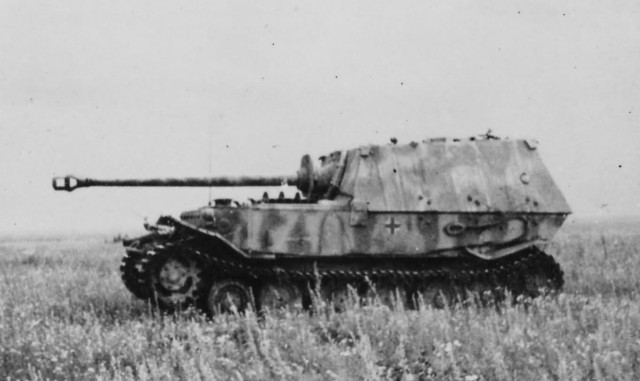 Heavy Tank Destroyer Ferdinand
Heavy Tank Destroyer FerdinandThe Ferdinand was optimized for destroying Soviet T-34 tanks and 76.2mm anti-tank guns from behind the front lines with its main gun at a range of over 3 kilometres, a role which it performed well.
Soviet infantry, quickly recognizing this flaw, could easily hide in their trenches until the Ferdinand advanced through their lines, then swarm the vehicle with grenades and Molotov cocktails from the sides.
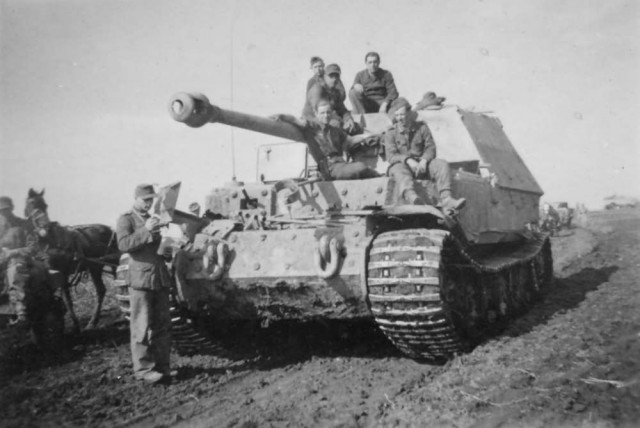 Elefant Panzerjager Abteilung 653 eastern front
Elefant Panzerjager Abteilung 653 eastern frontAny damage to the tracks or suspension negated the protection of the armor, as crews were forced to dismount and attempt repairs.
The extremely heavy weight of the Ferdinand made towing difficult: the standard armored recovery vehicle in German service at the time was the Bergepanzer IV, a variant of the Panzer IV which could tow a single Panzer IV without assistance.
It was insufficient for larger vehicles, with a Tiger I heavy tank requiring three Bergepanzer IVs to be towed, and the Ferdinand requiring five linked in tandem to pull the vehicle off the field.
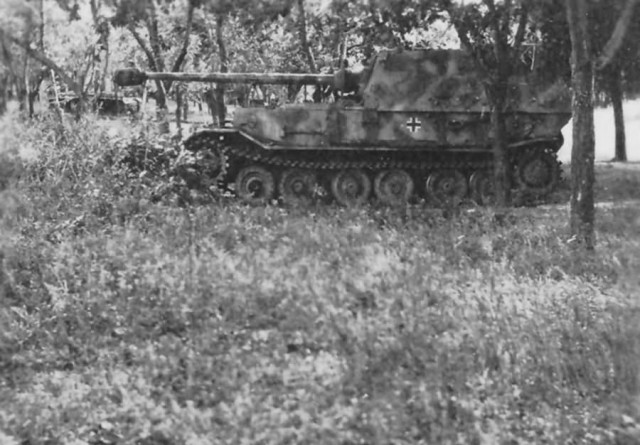 Ferdinand – Elefant 8,8 cm Pak 43/2 Sd Kfz 184 1944
Ferdinand – Elefant 8,8 cm Pak 43/2 Sd Kfz 184 1944In the initial stages of the Kursk battle, when the Germans were on the offensive, heavy vehicles could be recovered and repaired with relative peace at night; this, at first allowed the majority of knocked-out Ferdinands to be rescued, repaired and returned to duty.
However, once the tides had turned against the Germans and they fell back on the defensive, with fewer vehicles to spare, functional Ferdinands with minor damage to their tracks or suspensions had little hope of recovery, and crews were usually forced to destroy the vehicle to prevent a mostly intact tank destroyer from falling into the hands of the Soviets.
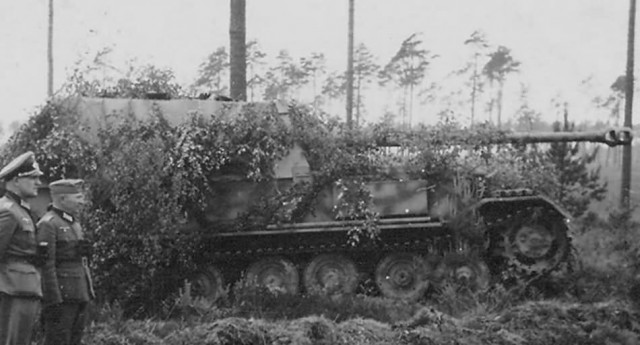 Elefant Panzerjager Sdkfz 184
Elefant Panzerjager Sdkfz 184Although the Elefant modifications improved the vehicles, some problems could never be fully fixed. In 1944 the Elefants served on the Italian front, but were rather ineffective as their weight of nearly 70 tonnes did not allow them to use most Italian roads and bridges.
As at Kursk, most Elefant losses were not as a direct result from combat, but resulted when mechanical breakdowns and lack of spare parts compelled their crews to destroy and abandon them.
One company of Elefants saw action during the Soviets’ January 1945 Vistula-Oder offensive in Poland, and the very last surviving vehicles were in combat at Zossen during the Battle of Berlin.
 Panzerjager Tiger (P) Elefant Sd.Kfz.184 of the 3/653 Schwere Panzerjäger-Abteilung 653, Poland 1944
Panzerjager Tiger (P) Elefant Sd.Kfz.184 of the 3/653 Schwere Panzerjäger-Abteilung 653, Poland 1944The Ferdinand may have been the most successful tank destroyer employed during the war in kills per loss, reaching an average ratio of approximately 10:1.
During the Battle of Kursk the 653rd Heavy Tank Destroyer Battalion claimed to have knocked out 320 enemy tanks, for the loss of 13 Ferdinands.
This impressive average ratio was due to its extreme firepower and protection, which gave it an enormous advantage when used in head-on combat or a static defensive role. However, poor mobility and mechanical unreliability greatly diminished its operational capability.
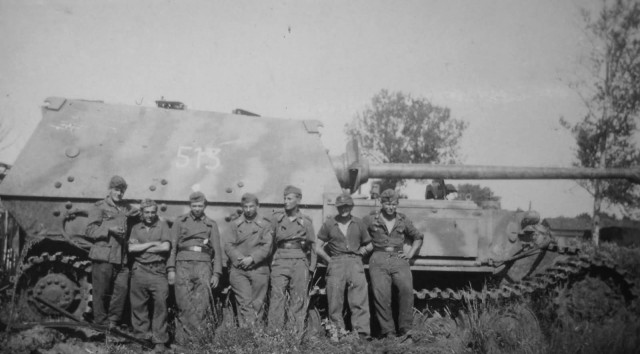 Ferdinand number 513 of the schwere Panzerjäger-Abteilung 654 – 1943
Ferdinand number 513 of the schwere Panzerjäger-Abteilung 654 – 1943The Elefant and Nashorn were both superseded by the Jagdpanther. All three of those tanks mounted the same gun, with only some minor differences between them.
The Jagdpanther was a successor to both tanks before it, combining acceptable mobility and good armour while retaining the great gun, mostly solving the reliability and protection problems the earlier tanks had.
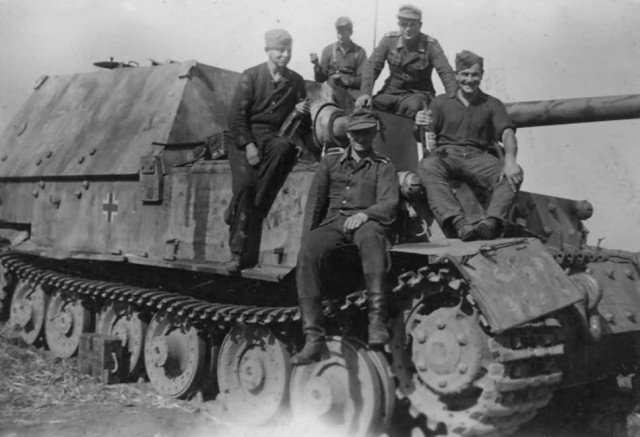 Ferdinand of the Panzer Jg Abt. 653 eastern front
Ferdinand of the Panzer Jg Abt. 653 eastern frontOnly two of these vehicles survived the war. One Ferdinand was captured by Soviet forces at Kursk, and is now at the Kubinka Tank Museum outside Moscow.
An Elefant was captured at Anzio by the Americans, and is now part of the United States Army Ordnance Museum’s collection at Fort Lee, VA. The example at Fort Lee was restored to display condition in 2007–2008.
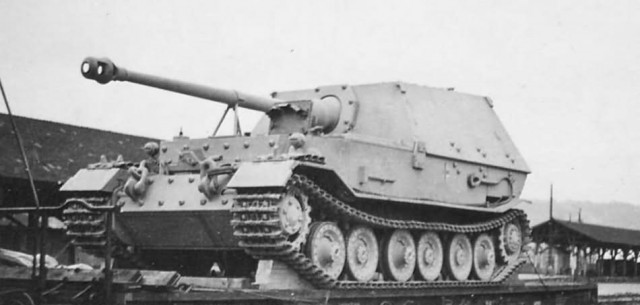 Ferdinand Elefant Tank Destroyer rail transport
Ferdinand Elefant Tank Destroyer rail transport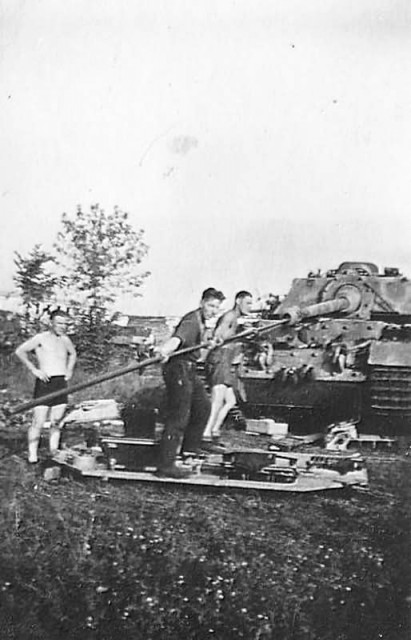 Elefant Ferdinand Schw.Pz.Jg.Abt. 653 Cleaning the Barrel
Elefant Ferdinand Schw.Pz.Jg.Abt. 653 Cleaning the Barrel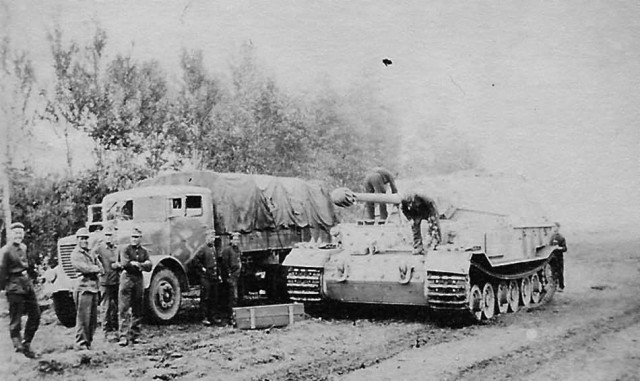 Heavy tank destroyer Ferdinand Elefant being resupplied
Heavy tank destroyer Ferdinand Elefant being resupplied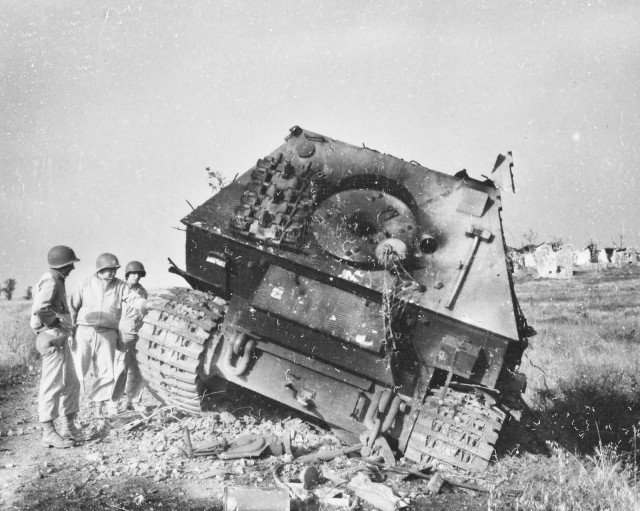 Heavy tank destroyer Ferdinand Elephant of the 1/653 Schwere Panzerjäger-Abteilung 653, knocked out at Anzio Italy May 1944.
Heavy tank destroyer Ferdinand Elephant of the 1/653 Schwere Panzerjäger-Abteilung 653, knocked out at Anzio Italy May 1944.
Δεν υπάρχουν σχόλια:
Δημοσίευση σχολίου